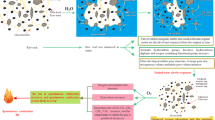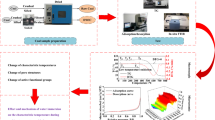Abstract
Low-rank coals may undergo low-temperature oxidation and self-heating during mining, freightage, and handling. The oxidation of coal changes its structure which will be relected in the behaviour of coal water. A differential scanning calorimetry study was conducted to investigate the impact of low-temperature oxidation on the nature of water in a Chinese lignite and its drying behavior. The lignite sample was oxidized in the air at temperatures of 30–180 °C. The results showed that the lignite samples that underwent low-temperature oxidation did not contain any freezable bound water. It was found that the amount of non-freezable water in the oxidized samples reached the highest value of 67.38 mass% after oxidation at 80 °C. The Fourier transform infrared spectroscopy and the static sessile drop analysis results suggested that the concentration of oxygen functionalities and hydrophilicity of lignite samples peaked after oxidation at 80 °C, which in turn increased the tendency for the absorption of water as non-freezable water. It was also found that the types of water in the oxidized samples had a profound impact on its drying behavior, where free water showed higher drying rates compared with freezable bound water and non-freezable water. The coal sample pre-oxidized at 80 °C required higher energy for pre-drying compared with the raw coal, which was attributed to the higher proportion of non-freezable water after oxidation.








Similar content being viewed by others
References
Karthikeyan M, Zhonghua W, Mujumdar AS. Low-rank coal drying technologies—current status and new developments. Dry Technol. 2009;27:403–15.
Jangam SV, Karthikeyan M, Mujumdar AS. A critical assessment of industrial coal drying technologies: role of energy, emissions, risk and sustainability. Dry Technol. 2011;29:395–407.
Allardice DJ, Clemow LM, Favas G, Jackson WR, Marshall M, Sakurovs R. The characterisation of different forms of water in low rank coals and some hydrothermally dried products☆. Fuel. 2003;82:661–7.
Yu J, Tahmasebi A, Han Y, Yin F, Li X. A review on water in low rank coals: the existence, interaction with coal structure and effects on coal utilization. Fuel Process Technol. 2013;106:9–20.
Norinaga K, Kumagai H, Hayashi J-I, Chiba T. Classification of water sorbed in coal on the basis of congelation characteristics. Energy Fuels. 1998;12:574–9.
Tahmasebi A, Yu J, Han Y, Zhao H, Bhattacharya S. A kinetic study of microwave and fluidized-bed drying of a Chinese lignite. Chem Eng Res Des. 2014;92:54–65.
Willson WG, Walsh DAN, Irwinc W. Overview of low-rank coal (LRC) drying. Coal Prep. 1997;18:1–15.
Wang H, Dlugogorski BZ, Kennedy EM. Coal oxidation at low temperatures: oxygen consumption, oxidation products, reaction mechanism and kinetic modelling. Prog Energy Combust Sci. 2003;29:487–513.
Slovák V, Taraba B. Effect of experimental conditions on parameters derived from TG-DSC measurements of low-temperature oxidation of coal. J Therm Anal Calorim. 2010;101:641–6.
Wang K, Deng J, Zhang Y-N, Wang C-P. Kinetics and mechanisms of coal oxidation mass gain phenomenon by TG–FTIR and in situ IR analysis. J Therm Anal Calorim. 2018;132:591–8.
Kus J, Misz-Kennan M. Coal weathering and laboratory (artificial) coal oxidation. Int J Coal Geol. 2017;171:12–36.
Lopez D, Sanada Y, Mondragon F. Effect of low-temperature oxidation of coal on hydrogen-transfer capability. Fuel. 1998;77:1623–8.
Qi G, Wang D, Zheng K, Xu J, Qi X, Zhong X. Kinetics characteristics of coal low-temperature oxidation in oxygen-depleted air. J Loss Prevent Proc. 2015;35:224–31.
Yuan L, Smith AC. CFD modeling of spontaneous heating in a large-scale coal chamber. J Loss Prevent Proc. 2009;22:426–33.
Clemens AH, Matheson TW. The role of moisture in the self-heating of low-rank coals. Fuel. 1996;75:891–5.
Tahmasebi A, Yu J, Han Y, Li X. A study of chemical structure changes of Chinese lignite during fluidized-bed drying in nitrogen and air. Fuel Process Technol. 2012;101:85–93.
Tahmasebi A, Yu J, Bhattacharya S. Chemical structure changes accompanying fluidized-bed drying of Victorian brown coals in superheated steam, nitrogen, and hot air. Energy Fuels. 2013;27:154–66.
Zhao H, Yu J, Liu J, Tahmasebi A. Experimental study on the self-heating characteristics of Indonesian lignite during low temperature oxidation. Fuel. 2015;150:55–63.
Akgün F, Arisoy A. Effect of particle size on the spontaneous heating of a coal stockpile. Combust Flame. 1994;99:137–46.
Wang H, Dlugogorski BZ, Kennedy EM. Analysis of the mechanism of the low-temperature oxidation of coal. Combust Flame. 2003;134:107–17.
Wang H, Dlugogorski BZ, Kennedy EM. Role of inherent water in low-temperature oxidation of coal. Combust Sci Technol. 2003;175:253–70.
Petit JC. A comprehensive study of the water vapour/coal system: application to the role of water in the weathering of coal. Fuel. 1991;70:1053–8.
Lynch LJ, Webster DS. Effect of thermal treatment on the interaction of brown coal and water: a nuclear magnetic resonance study. Fuel. 1982;61:271–5.
Unsworth JF, Fowler CS, Heard NA, Weldon VL, McBrierty VJ. Moisture in coal. Fuel. 1988;67:1111–9.
Tahmasebi A, Yu J, Su H, Han Y, Lucas J, Zheng H, et al. A differential scanning calorimetric (DSC) study on the characteristics and behavior of water in low-rank coals. Fuel. 2014;135:243–52.
Gaisford S, Kett V, Haines P. Principles of thermal analysis and calorimetry. London: Royal Society of Chemistry; 2016.
Groenewoud WM. Chapter 1—differential scanning calorimetry. In: Groenewoud WM, editor. Characterisation of polymers by thermal analysis. Amsterdam: Elsevier Science B.V; 2001. p. 10–60.
Höhne G, Hemminger WF, Flammersheim H-J. Differential scanning calorimetry. Berlin: Springer; 2013. p. 31–63.
Tahmasebi A, Yu J, Han Y, Yin F, Bhattacharya S, Stokie D. Study of chemical structure changes of Chinese lignite upon drying in superheated steam, microwave, and hot air. Energy Fuels. 2012;26:3651–60.
Meng F, Yu J, Tahmasebi A, Han Y, Zhao H, Lucas J, et al. Characteristics of chars from low-temperature pyrolysis of lignite. Energy Fuels. 2014;28:275–84.
Han Y, Liao J, Bai Z, Chaffee AL, Chang L, Li W. Study on the relationship between pore structure and water forms in pore using partially gasified lignite char. Energy Fuels. 2016;30:8875–85.
Ferrasse J-H, Lecomte D. Simultaneous heat-flow differential calorimetry and thermogravimetry for fast determination of sorption isotherms and heat of sorption in environmental or food engineering. Chem Eng Sci. 2004;59:1365–76.
Nwaka D, Tahmasebi A, Tian L, Yu J. The effects of pore structure on the behavior of water in lignite coal and activated carbon. J Colloid Interface Sci. 2016;477:138–47.
Hayashi J-I, Norinaga K, Kudo N, Chiba T. Estimation of size and shape of pores in moist coal utilizing sorbed water as a molecular probe. Energy Fuels. 2001;15:903–9.
Wang D, Zhong X, Gu J, Qi X. Changes in active functional groups during low-temperature oxidation of coal. Min Sci Technol (China). 2010;20:35–40.
Tekely P, Nicole D, Delpuech JJ, Totino E, Muller JF. Chemical structure changes in coals after low-temperature oxidation and demineralization by acid treatment as revealed by high resolution solid state 13C NMR. Fuel Process Technol. 1987;15:225–31.
Zhang Y, Li Y, Huang Y, Li S, Wang W. Characteristics of mass, heat and gaseous products during coal spontaneous combustion using TG/DSC–FTIR technology. J Therm Anal Calorim. 2018;131:2963–74.
Li Z, Zhang Y, Jing X, Zhang Y, Chang L. Insight into the intrinsic reaction of brown coal oxidation at low temperature: differential scanning calorimetry study. Fuel Process Technol. 2016;147:64–70.
Förch R, Schönherr H, Jenkins ATA. Surface design: applications in bioscience and nanotechnology. New York: Wiley; 2009.
Xia W, Xie G. Changes in the hydrophobicity of anthracite coals before and after high temperature heating process. Powder Technol. 2014;264:31–5.
Xia W, Yang J. Changes in surface properties of anthracite coal before and after inside/outside weathering processes. Appl Surf Sci. 2014;313:320–4.
Xia W. The effect of heating on the wettability of lignite. Energy Sour A. 2016;38:3521–6.
Zhou G, Xu C, Cheng W, Zhang Q, Nie W. Effects of oxygen element and oxygen-containing functional groups on surface wettability of coal dust with various metamorphic degrees based on XPS experiment. J Anal Methods Chem. 2015;2015:8.
Vorres KS. Effect of temperature, sample size, and gas flow rate on drying on Beulah-Zap lignite and Wyodak subbituminous coal. Energy Fuels. 1994;8:320–3.
Wang R, Liu J, Hu Y, Zhou J, Cen K. Ultrasonic sludge disintegration for improving the co-slurrying properties of municipal waste sludge and coal. Fuel Process Technol. 2014;125:94–105.
Weigl K, Schuster G, Stamatelopoulos GN, Friedl A. Increasing power plant efficiency by fuel drying. Comput Chem Eng. 1999;23:S919–22.
Acknowledgements
This study was supported by the National Natural Science Foundation of China (21476100 and 21676132).
Author information
Authors and Affiliations
Corresponding author
Additional information
Publisher's Note
Springer Nature remains neutral with regard to jurisdictional claims in published maps and institutional affiliations.
Rights and permissions
About this article
Cite this article
Rish, S.K., Tahmasebi, A. & Yu, J. A DSC study on the impact of low-temperature oxidation on the behavior and drying of water in lignite. J Therm Anal Calorim 139, 3507–3517 (2020). https://doi.org/10.1007/s10973-019-08749-w
Received:
Accepted:
Published:
Issue Date:
DOI: https://doi.org/10.1007/s10973-019-08749-w




